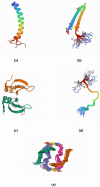The characteristics and roles of antimicrobial peptides as potential treatment for antibiotic-resistant pathogens: a review
- PMID: 35003909
- PMCID: PMC8679955
- DOI: 10.7717/peerj.12193
The characteristics and roles of antimicrobial peptides as potential treatment for antibiotic-resistant pathogens: a review
Abstract
The emergence of antibiotic-resistant bacteria has become a significant and ever-increasing threat to global public health, increasing both morbidity and mortality rates, and the financial burden on health services. Infection by drug-resistant bacteria is anticipated to contribute to the demise of almost 10 million people by the year 2050 unless a competent and effective response is devised to engage with this issue. The emergence and spread of resistance are commonly caused by the excessive or inappropriate use of antibiotics and substandard pharmaceuticals. It arises when pathogens adapt to different conditions and develop self-defence mechanisms. Currently, novel antimicrobial peptides (AMPs) have been reported to be the sole cure for some clinical cases of infectious diseases such as sepsis and skin infections, although these agents may, on occasion, require administration together with an adjunctive low-dose antibiotic. Although AMPs are a promising alternative form of anti-microbial therapy and easily applied in the medical sector, they still have limitations that should not be taken lightly. Hence, this review explores the characteristics, advantages and disadvantages of AMPs for their potential in treating antibiotic-resistant pathogens.
Keywords: AMPs; Antibiotic resistance; Antimicrobial peptides; Bacterial resistance; Bacteriocins; Mechanisms of action; Naturally Occurring AMPs; Synthetic AMPs.
©2021 Zainal Baharin et al.
Conflict of interest statement
The authors declare there are no competing interests.
Figures
Similar articles
-
Antimicrobial peptides: a promising frontier to combat antibiotic resistant pathogens.Ann Med Surg (Lond). 2025 Mar 27;87(4):2118-2132. doi: 10.1097/MS9.0000000000003106. eCollection 2025 Apr. Ann Med Surg (Lond). 2025. PMID: 40212220 Free PMC article. Review.
-
Efficiency of Antimicrobial Peptides Against Multidrug-Resistant Staphylococcal Pathogens.Front Microbiol. 2022 Jun 9;13:930629. doi: 10.3389/fmicb.2022.930629. eCollection 2022. Front Microbiol. 2022. PMID: 35756032 Free PMC article. Review.
-
Synergism between Host Defence Peptides and Antibiotics Against Bacterial Infections.Curr Top Med Chem. 2020;20(14):1238-1263. doi: 10.2174/1568026620666200303122626. Curr Top Med Chem. 2020. PMID: 32124698 Review.
-
Natural antimicrobial peptides from bacteria: characteristics and potential applications to fight against antibiotic resistance.J Appl Microbiol. 2012 Oct;113(4):723-36. doi: 10.1111/j.1365-2672.2012.05338.x. Epub 2012 Jun 8. J Appl Microbiol. 2012. PMID: 22583565 Review.
-
Application of Antimicrobial Peptides of the Innate Immune System in Combination With Conventional Antibiotics-A Novel Way to Combat Antibiotic Resistance?Front Cell Infect Microbiol. 2019 Apr 30;9:128. doi: 10.3389/fcimb.2019.00128. eCollection 2019. Front Cell Infect Microbiol. 2019. PMID: 31114762 Free PMC article.
Cited by
-
Repurposing HDAC inhibitors to enhance ribonuclease 4 and 7 expression and reduce urinary tract infection.Proc Natl Acad Sci U S A. 2023 Jan 24;120(4):e2213363120. doi: 10.1073/pnas.2213363120. Epub 2023 Jan 18. Proc Natl Acad Sci U S A. 2023. PMID: 36652479 Free PMC article.
-
Advances in Antimicrobial Peptides: Mechanisms, Design Innovations, and Biomedical Potential.Molecules. 2025 Mar 29;30(7):1529. doi: 10.3390/molecules30071529. Molecules. 2025. PMID: 40286095 Free PMC article. Review.
-
Computational analysis of antimicrobial peptides targeting key receptors in infection-related cardiovascular diseases: molecular docking and dynamics insights.Sci Rep. 2025 Mar 14;15(1):8896. doi: 10.1038/s41598-025-93683-1. Sci Rep. 2025. PMID: 40087360 Free PMC article.
-
10-mer and 9-mer WALK Peptides with Both Antibacterial and Anti-Inflammatory Activities.Antibiotics (Basel). 2022 Nov 10;11(11):1588. doi: 10.3390/antibiotics11111588. Antibiotics (Basel). 2022. PMID: 36358242 Free PMC article.
-
Overcoming Methicillin-Resistance Staphylococcus aureus (MRSA) Using Antimicrobial Peptides-Silver Nanoparticles.Antibiotics (Basel). 2022 Jul 15;11(7):951. doi: 10.3390/antibiotics11070951. Antibiotics (Basel). 2022. PMID: 35884205 Free PMC article. Review.
References
-
- Anderson GW, McGregor AC. t-Butyloxycarbonylamino acids and their use in peptide synthesis. Journal of American Chemical Society. 1957;79:6180–6183. doi: 10.1021/ja01580a020. - DOI
LinkOut - more resources
Full Text Sources




